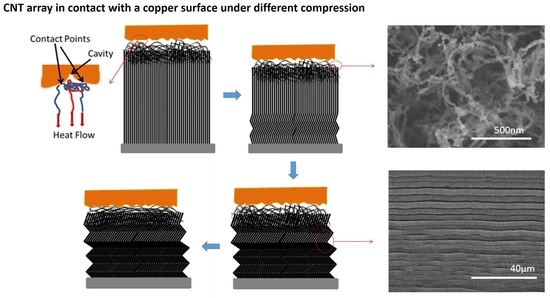Effect of Contact Pressure on the Performance of Carbon Nanotube Arrays Thermal Interface Material
Abstract
:1. Introduction
2. Materials and Methods
2.1. CNT Arrays Synthesis and Characterization
2.2. Thermal Measurement Setup
2.3. Measurement Principle
- j represents the jth layer (1 = glass, 2 = copper, 3 = CNTs, 4 = silicon),
- α is the thermal diffusivity,
- T is the temperature,
- k is cross-plane effective thermal conductivity,
- ω is the frequency of pump laser,
- h is the interface thermal conductance.
3. Results and Discussion
4. Conclusions
Author Contributions
Funding
Acknowledgments
Conflicts of Interest
References
- Kang, J.S.; Li, M.; Wu, H.; Nguyen, H.; Hu, Y. Experimental observation of high thermal conductivity in boron arsenide. Science 2018, 361, 575–578. [Google Scholar] [CrossRef] [PubMed]
- Prieto, R.; Molina, J.M.; Narciso, J.; Louis, E. Thermal conductivity of graphite flakes-SiC particles/metal composites. Compos. Part. A-Appl. Sci. Manuf. 2011, 42, 1970–1977. [Google Scholar] [CrossRef]
- Chu, R.-S.; Zhao, Y.; Grigoropoulos, C.P. Effect of copper surface roughness on thermal conductance of copper/carbon nanotube array interface. In 13th InterSociety Conference on Thermal and Thermomechanical Phenomena in Electronic Systems, Proceedings of the 13th InterSociety Conference on Thermal and Thermomechanical Phenomena in Electronic Systems, San Diego, CA, USA, 30 May–1 June 2012; IEEE: Piscataway, NJ, USA, 2012; pp. 10–14. [Google Scholar]
- Cao, A. Super-compressible foamlike carbon nanotube films. Science 2005, 310, 1307–1310. [Google Scholar] [CrossRef] [PubMed]
- Zhao, Y.; Tong, T.; Delzeit, L.; Kashani, A.; Meyyappan, M.; Majumdar, A. Interfacial energy and strength of multiwalled-carbon-nanotube-based dry adhesive. J. Vac. Sci. Technol. B Nanotechnol. Microelectron. Mater. Process. Meas. Phenom. 2006, 24, 331–335. [Google Scholar] [CrossRef]
- Suhr, J.; Victor, P.; Ci, L.; Sreekala, S.; Zhang, X.; Nalamasu, O.; Ajayan, P.M. Fatigue resistance of aligned carbon nanotube arrays under cyclic compression. Nat. Nanotechnol. 2007, 2, 417–421. [Google Scholar] [CrossRef] [PubMed]
- Tong, T.; Zhao, Y.; Delzeit, L.; Kashani, A.; Meyyappan, M.; Majumdar, A. Height independent compressive modulus of vertically aligned carbon nanotube arrays. Nano Lett. 2008, 8, 511–515. [Google Scholar] [CrossRef] [PubMed]
- Qu, L.; Dai, L.; Stone, M.; Xia, Z.; Wang, Z.L. Carbon nanotube arrays with strong shear binding-on and easy normal lifting-off. Science 2008, 322, 238–242. [Google Scholar] [CrossRef] [PubMed]
- Berber, S.; Kwon, Y.-K.; Tománek, D. Unusually high thermal conductivity of carbon nanotubes. Phys. Rev. Lett. 2000, 84, 4613–4616. [Google Scholar] [CrossRef] [PubMed]
- Fujii, M.; Zhang, X.; Xie, H.; Ago, H.; Takahashi, K.; Ikuta, T.; Abe, H.; Shimizu, T. Measuring the thermal conductivity of a single carbon nanotube. Phys. Rev. Lett. 2005, 95, 065502. [Google Scholar] [CrossRef] [PubMed]
- Pop, E.; Mann, D.; Wang, Q.; Goodson, K.; Dai, H. Thermal conductance of an individual single-wall carbon nanotube above room temperature. Nano Lett. 2006, 6, 96–100. [Google Scholar] [CrossRef] [PubMed]
- Pettes, M.T.; Shi, L. Thermal and structural characterizations of individual single-, double-, and multi-walled carbon nanotubes. Adv. Funct. Mater. 2009, 19, 3918–3925. [Google Scholar] [CrossRef]
- Kim, P.; Shi, L.; Majumdar, A.; McEuen, P.L. Thermal transport measurements of individual multiwalled nanotubes. Phys. Rev. Lett. 2001, 87, 215502. [Google Scholar] [CrossRef] [PubMed]
- Caccia, M.; Rodríguez, A.; Narciso, J. Diamond surface modification to enhance interfacial thermal conductivity in Al/diamond composites. JOM 2014, 66, 920–925. [Google Scholar] [CrossRef]
- Tong, T.; Zhao, Y.; Delzeit, L.; Kashani, A.; Meyyappan, M.; Majumdar, A. Dense vertically aligned multiwalled carbon nanotube arrays as thermal interface materials. IEEE Trans. Compon. Packag. Technol. 2007, 30, 92–100. [Google Scholar] [CrossRef]
- Cola, B.A.; Xu, J.; Fisher, T.S. Contact mechanics and thermal conductance of carbon nanotube array interfaces. Int. J. Heat Mass Transf. 2009, 52, 3490–3503. [Google Scholar] [CrossRef]
- Kaur, S.; Raravikar, N.; Helms, B.A.; Prasher, R.; Ogletree, D.F. Enhanced thermal transport at covalently functionalized carbon nanotube array interfaces. Nat. Commun. 2014, 5, 3082. [Google Scholar] [CrossRef] [PubMed] [Green Version]
- Cho, J.; Richards, C.; Bahr, D.; Jiao, J.; Richards, R. Evaluation of contacts for a MEMS thermal switch. J. Micromech. Microeng. 2008, 18, 105012. [Google Scholar] [CrossRef]
- Pathak, S. Collective behaviour of vertically aligned carbon nanotubes: from a single tube towards complex networks. In Structure and Multiscale Mechanics of Carbon Nanomaterials; Paris, O., Ed.; Springer Vienna: Vienna, Austria, 2016; Volume 563, pp. 191–226. [Google Scholar]
- Zhao, Y.; Chu, R.-S.; Grigoropoulos, C.P.; Dubon, O.D.; Majumdar, A. Array volume fraction-dependent thermal transport properties of vertically aligned carbon nanotube arrays. J. Heat Transf. 2016, 138, 092401. [Google Scholar] [CrossRef]
- Ohsone, Y.; Wu, G.; Dryden, J.; Zok, F.; Majumdar, A. Optical measurement of thermal contact conductance between wafer-like thin solid samples. J. Heat Transf. 1999, 121, 954. [Google Scholar] [CrossRef]
- Lu, Q.; Keskar, G.; Ciocan, R.; Rao, R.; Mathur, R.B.; Rao, A.M.; Larcom, L.L. Determination of carbon nanotube density by gradient sedimentation. J. Phys. Chem. B 2006, 110, 24371–24376. [Google Scholar] [CrossRef] [PubMed]
- Feng, X.; King, C.; Narumanchi, S. General multilayer heat transfer model for optical-based thermal characterization techniques. Int. J. Heat Mass Transf. 2016, 93, 695–706. [Google Scholar] [CrossRef]
- Jiang, P.; Huang, B.; Koh, Y.K. Accurate measurements of cross-plane thermal conductivity of thin films by dual-frequency time-domain thermoreflectance (TDTR). Rev. Sci. Instrum. 2016, 87, 075101. [Google Scholar] [CrossRef] [PubMed] [Green Version]
- Cahill, D.G. Analysis of heat flow in layered structures for time-domain thermoreflectance. Rev. Sci. Instrum. 2004, 75, 5119. [Google Scholar] [CrossRef]
- Incropera, F.; Dewitt, D. Introduction to heat transfer; John Wiley & Sons: New York, NY, USA, 1985; pp. 43–51. [Google Scholar]
- Gundrum, B.C.; Cahill, D.G.; Averback, R.S. Thermal conductance of metal-metal interfaces. Phys. Rev. B 2005, 72, 245426. [Google Scholar] [CrossRef]
- Mizel, A.; Benedict, L.X.; Cohen, M.L.; Louie, S.G.; Zettl, A.; Budraa, N.K.; Beyermann, W.P. Analysis of the low-temperature specific heat of multiwalled carbon nanotubes and carbon nanotube ropes. Phys. Rev. B 1999, 60, 3264–3270. [Google Scholar] [CrossRef]
- Choi, T.Y.; Poulikakos, D.; Tharian, J.; Sennhauser, U. Measurement of thermal conductivity of individual multiwalled carbon nanotubes by the 3-ω method. Appl. Phys. Lett. 2005, 87, 013108. [Google Scholar] [CrossRef]
- Pathak, S.; Mohan, N.; Decolvenaere, E.; Needleman, A.; Bedewy, M.; Hart, A.J.; Greer, J.R. Local relative density modulates failure and strength in vertically aligned carbon nanotubes. ACS Nano 2013, 7, 8593–8604. [Google Scholar] [CrossRef] [PubMed]
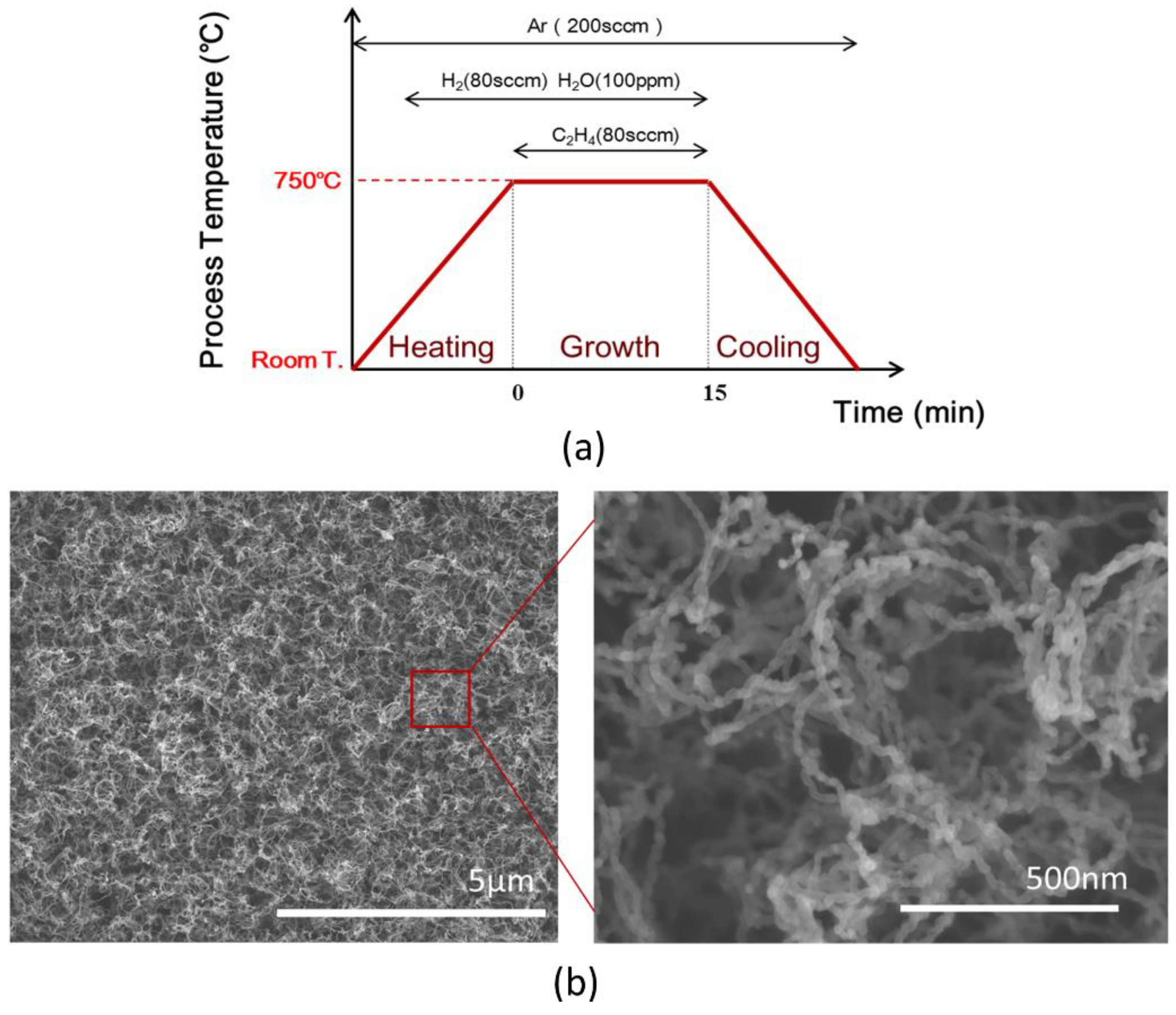
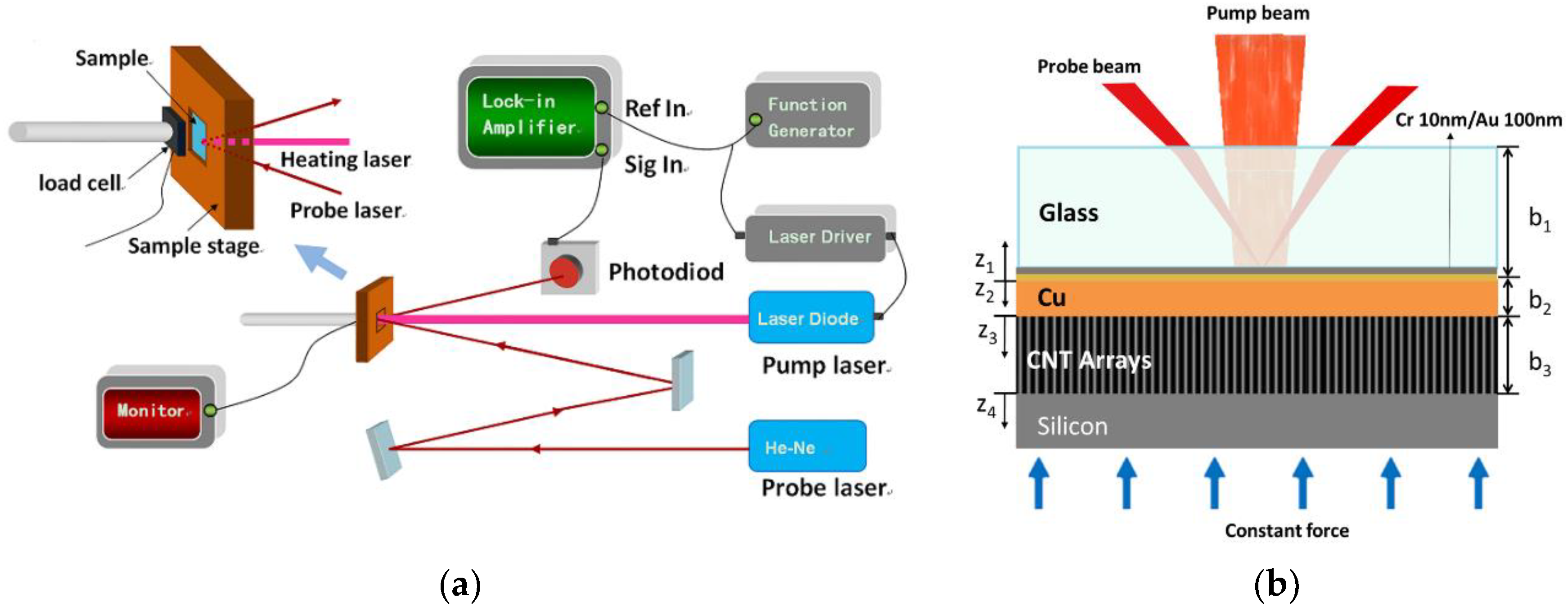
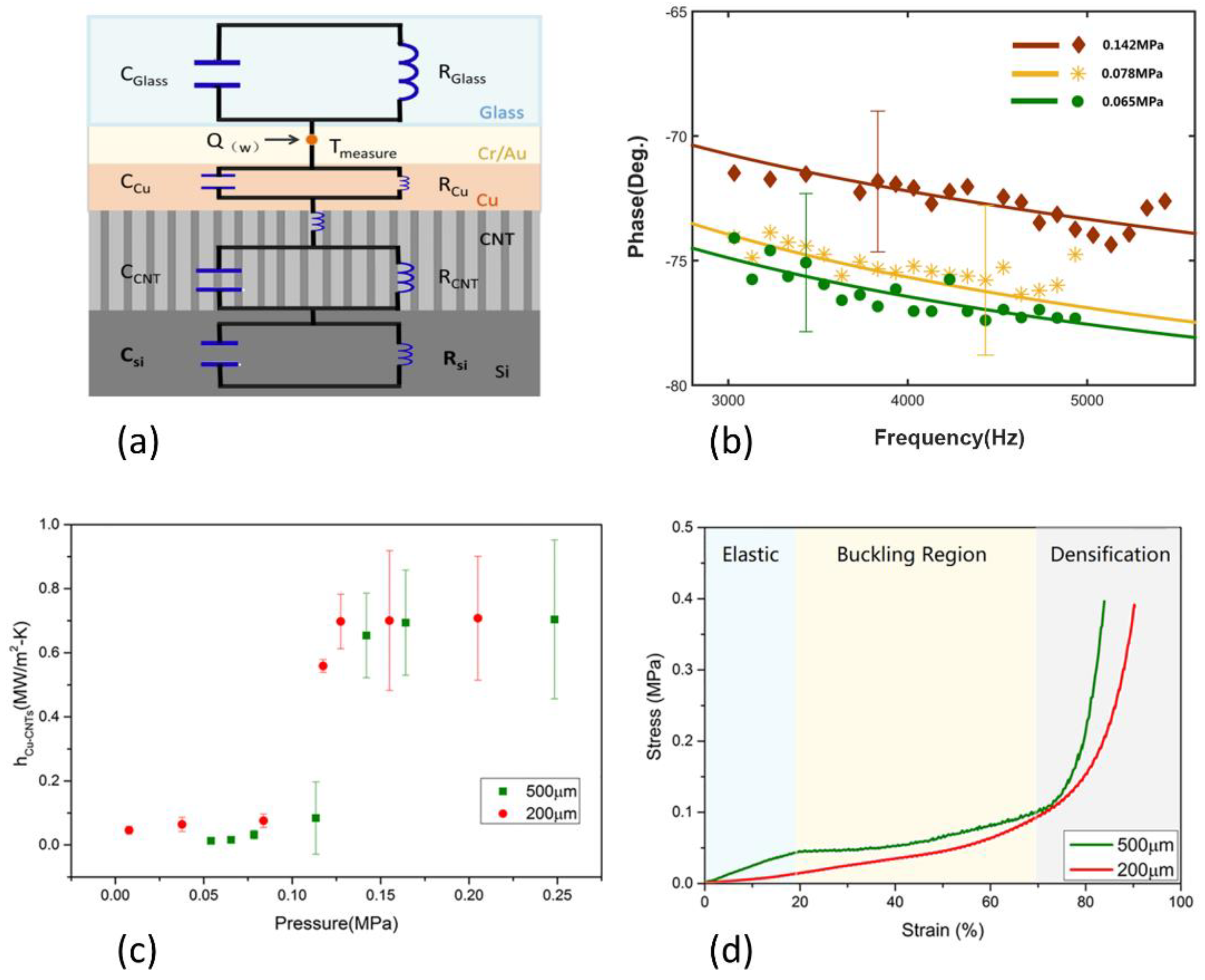
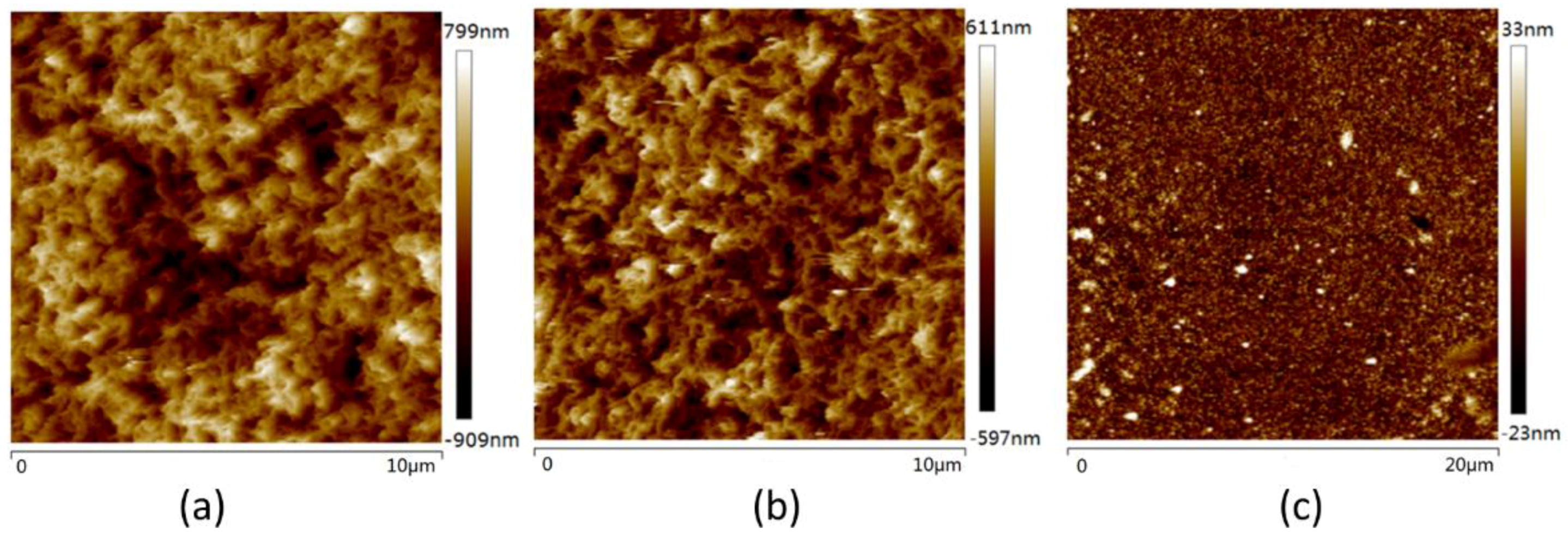
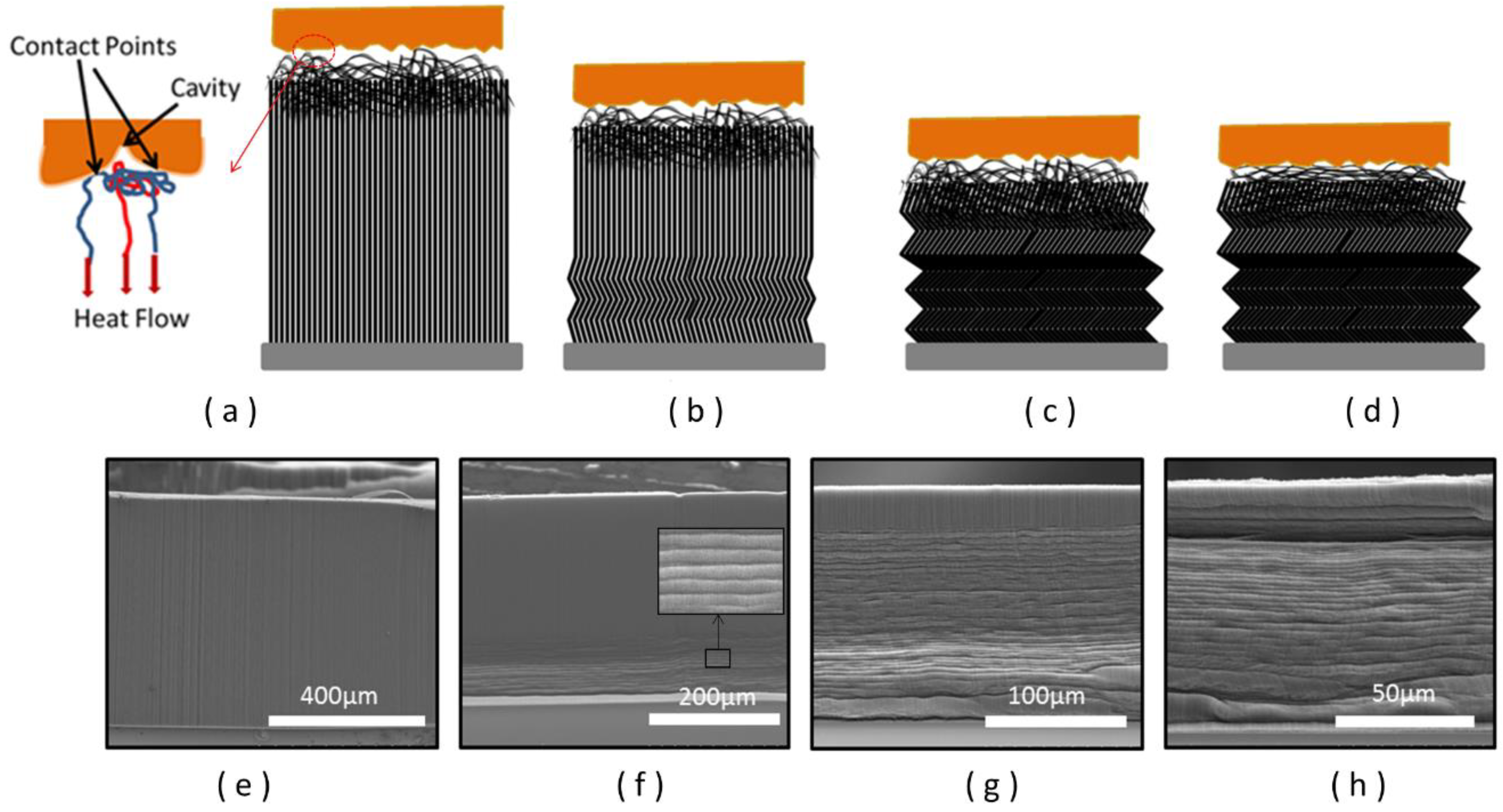
| Height of CNT Array | Parameters | Values | ||||||
|---|---|---|---|---|---|---|---|---|
| 500 μm | Pressure | 0.054 | 0.065 | 0.078 | 0.113 | 0.142 | 0.164 | 0.248 |
| (MPa) | ||||||||
| hCu-CNTs | 0.007 | 0.008 | 0.024 | 0.084 | 0.654 | 0.694 | 0.704 | |
| (MW/m2·K) | ||||||||
| 200 μm | Pressure | 0.008 | 0.038 | 0.084 | 0.118 | 0.128 | 0.155 | 0.205 |
| (MPa) | ||||||||
| hCu-CNTs | 0.046 | 0.064 | 0.076 | 0.559 | 0.698 | 0.700 | 0.708 | |
| (MW/m2·K) | ||||||||
© 2018 by the authors. Licensee MDPI, Basel, Switzerland. This article is an open access article distributed under the terms and conditions of the Creative Commons Attribution (CC BY) license (http://creativecommons.org/licenses/by/4.0/).
Share and Cite
Pei, Y.; Zhong, H.; Wang, M.; Zhang, P.; Zhao, Y. Effect of Contact Pressure on the Performance of Carbon Nanotube Arrays Thermal Interface Material. Nanomaterials 2018, 8, 732. https://doi.org/10.3390/nano8090732
Pei Y, Zhong H, Wang M, Zhang P, Zhao Y. Effect of Contact Pressure on the Performance of Carbon Nanotube Arrays Thermal Interface Material. Nanomaterials. 2018; 8(9):732. https://doi.org/10.3390/nano8090732
Chicago/Turabian StylePei, Yu, Hongmei Zhong, Mengyu Wang, Peng Zhang, and Yang Zhao. 2018. "Effect of Contact Pressure on the Performance of Carbon Nanotube Arrays Thermal Interface Material" Nanomaterials 8, no. 9: 732. https://doi.org/10.3390/nano8090732




